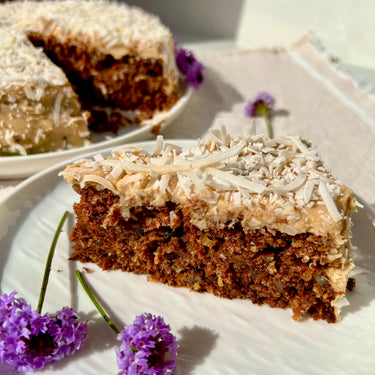
Gluten-free Classic Carrot Cake
Every year for my birthday, my mom would bake me a carrot cake at my own request. It is still, to this day, my favorite cake. I love its tender texture and unique spiced flavor. I prefer it without raisins, but you could add some to this, and it will work well. I was skeptical about adapting this recipe for date sugar because my child self didn’t want my special cake to be ruined. However, the deep caramelly notes of date sugar lends itself very well to this cake and not only makes it low-sugar but – dare I say – enhances the flavor! I also made sure it was gluten-free because, alas, that’s a requirement for me now, and I’m happy to announce the 1:1 flour didn’t make a bit of a difference. To this day, I have a firm belief that the morning after your birthday, you get to eat cake for breakfast, and this one does the trick big time.
Ingredients
1.5 cups gluten-free 1:1 flour
2 teaspoons baking powder
2 teaspoons baking soda
2 teaspoons ground cinnamon
¾ teaspoon salt
3 cups grated carrots (you can grate the carrots in a food processor fitted with a shredding blade)
1 cup coarsely chopped walnuts or pecans (optional)
1 cup shredded coconut, unsweetened (optional)
½ cup moist plump raisins (optional)
2 cups date sugar
1 cup canola or safflower oil
4 large eggs
Filling
1 cup coconut yogurt
1 cup date sugar
Cream cheese frosting
8oz organic cream cheese, softened
1/2 cup unsalted butter, softened (1 stick)
1 tsp vanilla
1/2 cup date sugar
unsweetened flaked coconut for decoration
Start by preheating the oven to 325 degrees and positioning the oven racks to divide it into thirds. Butter and flour three 9-inch round, 2-inch deep cake pans.
Next, whisk together the flour, cinnamon, baking powder, baking soda, and salt in a separate bowl and set it aside. In another bowl, stir together the grated carrots, chopped nuts, coconut, and raisins until well incorporated.
In a mixer fitted with the paddle attachment or a large bowl with a whisk, beat the date sugar and oil together until smooth. Add the eggs one by one and continue beating on high until the batter is smooth. If necessary, remove the bowl from the stand mixer and do this next part by hand. Switch to a large rubber spatula and gently stir in the flour mixture, mixing only until the dry ingredients disappear. Just as gently, stir in the chunky ingredients.
Divide the batter among the baking pans and smooth out the tops as much as you possibly can. Slide the pans into the oven. Bake the cakes for 30-35 minutes, rotating the pans top to bottom and front to back at the midway point. The cakes are done when a knife inserted into the centers of the cakes comes out clean, and the cakes just start to come away from the edges. Transfer the pans to cooling racks, cool for 5 minutes, then turn out onto racks to cool to room temperature. The cakes can be wrapped airtight and kept at room temperature overnight. Make sure you assemble the cakes when they are at room temperature.
To make the frosting, beat the cream cheese and butter together in a mixer fitted with the paddle attachment until smooth and creamy. Add the vanilla. Gradually add the date sugar and continue to beat until the frosting is smooth.
To make the filling, simply combine coconut yogurt with the date sugar until smooth. It will be a bit sticky and the color of peanut butter.
To assemble the cake, place one layer of the cake, right-side up, on a cardboard round or cake plate. Use half of the filling to generously cover the first layer. Top with the second layer, placing the cake top-side down. Frost with the remainder of the coconut frosting. Top with the last layer, right-side up, and use the cream cheese frosting to cover the top and sides of the cake. Finish the top layer with swirls of frosting. If desired, top the cake with toasted nuts or flaked coconut, while the frosting is soft. Slide the cake into the refrigerator for 15 minutes to set the frosting.
The cake can be served as soon as the frosting is set or stored covered at room temperature for 2 to 3 days. It can also be frozen, uncovered, and then wrapped airtight when firm, and kept in the freezer for up to 2 months. Defrost it while still wrapped in the refrigerator overnight. Serve the cake in thick slices at room temperature and, if desired, with whipped coconut cream.
adapted from NYT carrot cake by Caitlin Heinz



